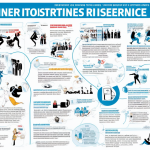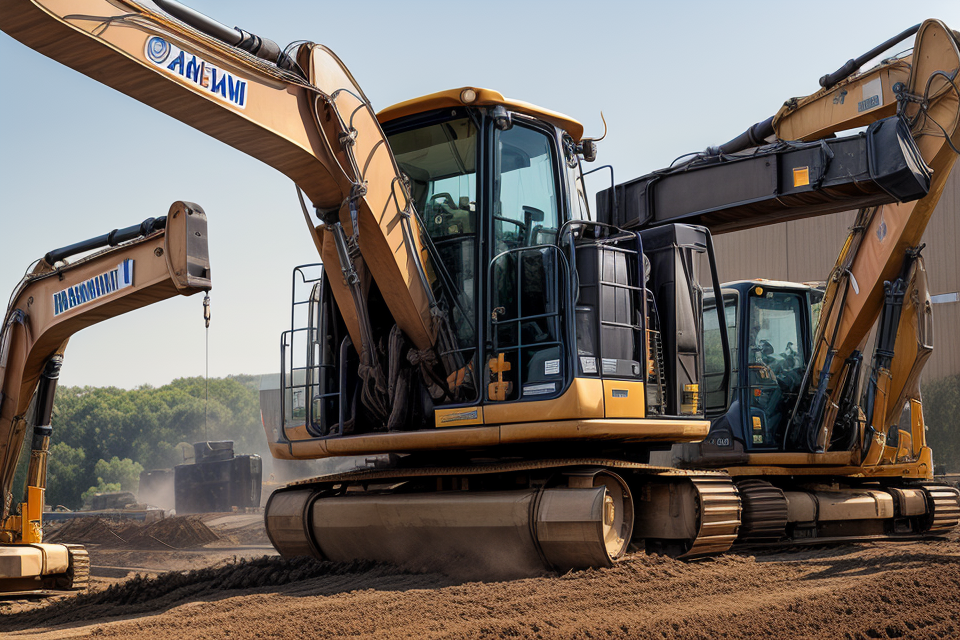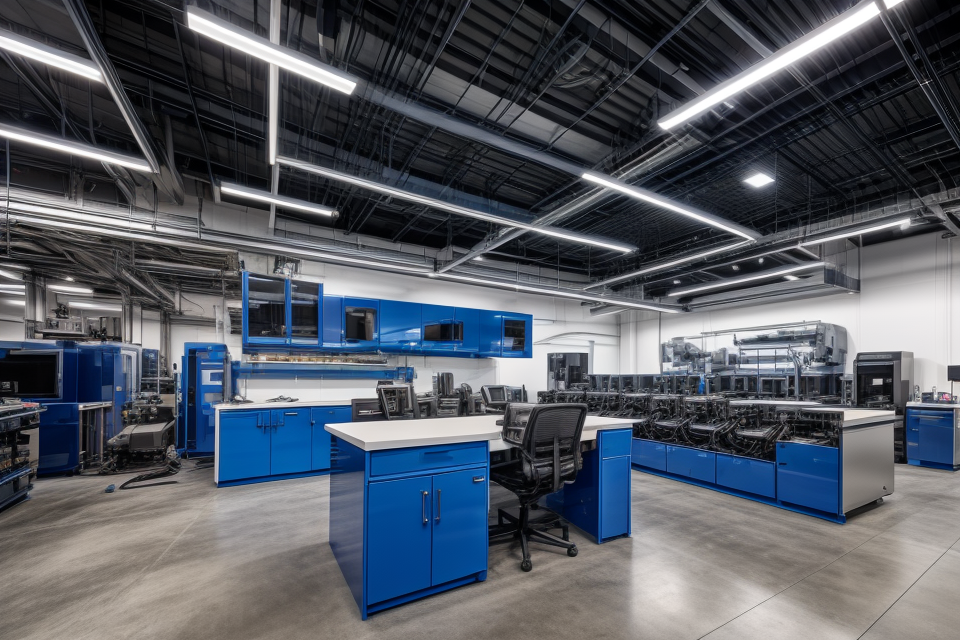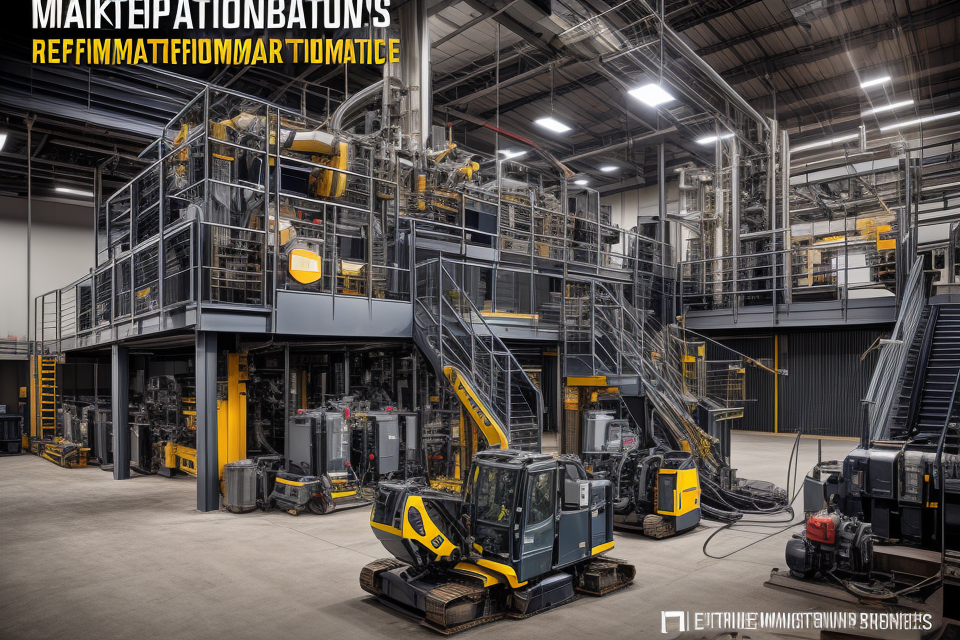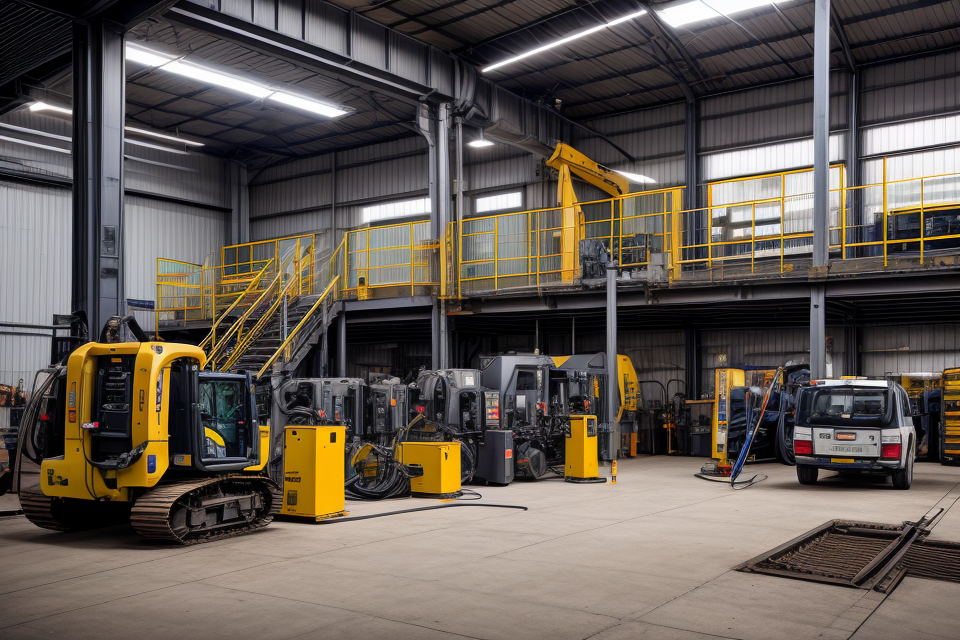In any industrial or commercial setting, equipment is a crucial part of the operations. From manufacturing to transportation, these machines play a vital role in keeping the business running smoothly. However, as with any machine, regular maintenance is essential to ensure optimal performance and prevent breakdowns. But with so many pieces of equipment to keep track of, it can be challenging to determine which ones need to be scheduled for maintenance. This comprehensive guide will provide an overview of the equipment that must be scheduled for maintenance to keep your business running smoothly.
Identifying Equipment for Maintenance
Importance of Equipment Maintenance
- Increases equipment lifespan
- Reduces downtime and maintenance costs
- Ensures safety and efficiency
Increases Equipment Lifespan
Proper maintenance can extend the lifespan of equipment by preventing wear and tear and detecting issues before they become major problems. This is particularly important for expensive and critical equipment that is essential to the smooth operation of a business.
Reduces Downtime and Maintenance Costs
Regular maintenance can help identify potential issues before they cause a breakdown, reducing the likelihood of unexpected downtime. This can help businesses avoid costly repairs and replacements, as well as the lost productivity that comes with downtime. In addition, scheduled maintenance can be planned and budgeted for, reducing the need for emergency repairs and their associated costs.
Ensures Safety and Efficiency
Regular maintenance can also help ensure that equipment is operating safely and efficiently. This is particularly important for equipment that is used in hazardous or high-risk environments, where even a small malfunction can have serious consequences. By keeping equipment in good working order, businesses can reduce the risk of accidents and injuries, as well as improve the overall efficiency of their operations.
Factors to Consider When Scheduling Maintenance
- Manufacturer Recommendations
- Regular inspection and maintenance schedule recommended by the manufacturer for optimal performance and longevity of the equipment.
- Consulting the user manual or contacting the manufacturer’s customer service for specific recommendations based on the equipment’s model and age.
- Environmental Conditions
- Factors such as temperature, humidity, and air quality can impact the wear and tear of equipment.
- For example, equipment in areas with high temperatures and humidity may require more frequent maintenance to prevent corrosion and rusting.
- Usage Patterns
- The frequency and intensity of equipment usage can impact its maintenance needs.
- Equipment that is used heavily or continuously may require more frequent maintenance to prevent breakdowns and extend its lifespan.
- Operator Feedback
- Operators may have a good understanding of the equipment’s performance and any issues they have encountered.
- Regular communication with operators can provide valuable insights into potential maintenance needs and help identify any potential issues before they become serious problems.
Types of Equipment to Schedule for Maintenance
Regular equipment maintenance is essential for extending the lifespan of equipment, reducing downtime and maintenance costs, and ensuring safety and efficiency in various industries. Different types of equipment, such as production, support, transportation, and facility equipment, must be scheduled for maintenance to ensure smooth operations. Manufacturers should consider factors like manufacturer recommendations, environmental conditions, and usage patterns when scheduling maintenance. Regular inspections, cleaning, lubrication, calibration, and alignment checks, and preventative maintenance schedules are necessary for different types of equipment. Best practices for equipment maintenance include establishing a preventative maintenance program, utilizing condition monitoring techniques, regularly replacing worn or broken parts, and planning for equipment retirement. By following these practices, businesses can minimize downtime, increase productivity, reduce costs, and maintain a competitive edge in the marketplace.
Production Equipment
- Machines used in manufacturing processes
- Examples: assembly lines, conveyor belts, and packaging equipment
Production equipment is a critical component of any manufacturing process. These machines are responsible for converting raw materials into finished products, and their proper functioning is essential to maintaining efficiency and productivity. In this section, we will discuss the different types of production equipment that must be scheduled for maintenance.
Assembly Lines
Assembly lines are a series of workstations where parts are assembled to create a finished product. These machines are responsible for moving parts along the production line, and they require regular maintenance to ensure that they are functioning properly. Some of the key components that require maintenance include motors, belts, and bearings.
Conveyor Belts
Conveyor belts are used to transport parts from one workstation to another. These machines require regular maintenance to ensure that they are functioning properly and that parts are being transported efficiently. Some of the key components that require maintenance include the belts themselves, motors, and rollers.
Packaging Equipment
Packaging equipment is used to package finished products for shipment. These machines require regular maintenance to ensure that they are functioning properly and that products are being packaged efficiently. Some of the key components that require maintenance include motors, belts, and seals.
In conclusion, production equipment is a critical component of any manufacturing process. These machines require regular maintenance to ensure that they are functioning properly and efficiently. By scheduling regular maintenance for these machines, manufacturers can minimize downtime, increase productivity, and reduce costs.
Support Equipment
- Equipment that supports production equipment
- Examples: HVAC systems, electrical systems, and compressed air systems
Support equipment refers to any equipment that is essential for the proper functioning of production equipment. These systems are often critical to the manufacturing process and must be kept in good working order to ensure smooth operations. Examples of support equipment include HVAC systems, electrical systems, and compressed air systems.
HVAC Systems
HVAC systems, or heating, ventilation, and air conditioning systems, are essential for maintaining the proper temperature and air quality in a facility. These systems help to regulate the temperature, humidity, and air flow in a room, which is crucial for the safe and efficient operation of production equipment. Regular maintenance of HVAC systems can help to prevent breakdowns, reduce energy consumption, and extend the lifespan of the equipment.
Electrical Systems
Electrical systems are a critical component of any manufacturing facility. These systems provide power to production equipment and are essential for the proper functioning of the facility. Regular maintenance of electrical systems can help to prevent power outages, reduce the risk of electrical fires, and ensure that the equipment is operating safely and efficiently.
Compressed Air Systems
Compressed air systems are used to supply air to production equipment, such as pneumatic tools and machinery. These systems are essential for the proper functioning of many production processes and must be kept in good working order to ensure smooth operations. Regular maintenance of compressed air systems can help to prevent leaks, reduce energy consumption, and extend the lifespan of the equipment.
Overall, support equipment is essential for the proper functioning of production equipment in a manufacturing facility. Regular maintenance of these systems can help to prevent breakdowns, reduce energy consumption, and extend the lifespan of the equipment. By prioritizing the maintenance of support equipment, manufacturers can ensure smooth operations and maintain a competitive edge in the marketplace.
Transportation Equipment
Equipment Used for Transportation
Transportation equipment refers to machines and vehicles that are used to transport people or goods from one place to another. These machines are critical to the smooth operation of any business that relies on transportation, and they require regular maintenance to ensure that they are always in good working condition.
Examples of Transportation Equipment
Some examples of transportation equipment that must be scheduled for maintenance include:
- Vehicles: This includes cars, trucks, buses, and any other vehicles that are used for transportation. Regular maintenance for these vehicles includes oil changes, tire rotations, and inspections of the brakes, suspension, and engine.
- Forklifts: Forklifts are used in warehouses and distribution centers to move heavy loads. They require regular maintenance to ensure that they are operating safely and efficiently. This includes checking the batteries, hydraulic systems, and the overall structural integrity of the forklift.
- Heavy machinery: Heavy machinery such as cranes, bulldozers, and excavators are used in construction and other heavy-duty applications. They require regular maintenance to ensure that they are operating safely and efficiently. This includes checking the brakes, hydraulic systems, and the overall structural integrity of the machinery.
Regular maintenance of transportation equipment is crucial to ensure that they are always in good working condition. By scheduling regular maintenance, businesses can prevent breakdowns, reduce downtime, and extend the lifespan of their equipment.
Facility Equipment
When it comes to scheduling equipment for maintenance, facility equipment should not be overlooked. These are the pieces of equipment that are used to maintain the facilities themselves, and they play a crucial role in ensuring that the facilities are safe, functional, and comfortable for the people who use them. Here are some examples of facility equipment that should be scheduled for maintenance:
- Plumbing systems: Plumbing systems are responsible for delivering water and removing waste from a facility. Over time, these systems can become clogged, corroded, or damaged, which can lead to leaks, flooding, and other problems. Regular maintenance of plumbing systems can help prevent these issues and keep the facilities running smoothly.
- Lighting systems: Lighting systems are essential for providing illumination in facilities, but they can also become worn out or damaged over time. Regular maintenance of lighting systems can help ensure that they are functioning properly and that they are using energy efficiently.
- Security systems: Security systems are designed to protect facilities and the people who use them. However, these systems can also become outdated or damaged, which can compromise their effectiveness. Regular maintenance of security systems can help ensure that they are functioning properly and that they are able to detect and respond to potential threats.
Overall, facility equipment is an important aspect of any facility, and regular maintenance is essential for keeping these systems running smoothly. By scheduling regular maintenance for facility equipment, you can help prevent problems, extend the lifespan of the equipment, and ensure that the facilities are safe and comfortable for everyone who uses them.
Scheduling Maintenance for Different Types of Equipment
When it comes to production equipment, it is essential to ensure that everything is running smoothly and efficiently. Regular maintenance can help prevent costly downtime and ensure that your equipment is operating at peak performance. Here are some of the key tasks that should be included in your production equipment maintenance schedule:
Regular Inspections and Cleaning
Regular inspections and cleaning are critical to the proper functioning of production equipment. This includes checking for signs of wear and tear, such as loose bolts or damaged parts, and cleaning the equipment to remove dirt and debris that can accumulate over time. By regularly inspecting and cleaning your equipment, you can help prevent breakdowns and extend the life of your equipment.
Regular Lubrication and Greasing
Lubrication and greasing are essential to the smooth operation of production equipment. Over time, equipment can become dry and worn, which can cause friction and wear on moving parts. Regular lubrication and greasing can help reduce friction, minimize wear and tear, and extend the life of your equipment.
Calibration and Alignment Checks
Calibration and alignment checks are important for ensuring that your production equipment is operating correctly. Equipment that is not properly calibrated or aligned can produce defective products, which can lead to costly waste and lost revenue. By regularly checking the calibration and alignment of your equipment, you can help ensure that your equipment is producing high-quality products consistently.
Preventative Maintenance Schedules
Preventative maintenance is the best way to keep your production equipment running smoothly. By creating a preventative maintenance schedule, you can proactively identify and address potential issues before they become serious problems. This can include tasks such as replacing filters, checking fluid levels, and inspecting electrical connections. By investing in preventative maintenance, you can help minimize downtime, extend the life of your equipment, and reduce repair costs.
Regular inspections and cleaning
Regular inspections and cleaning are essential for support equipment to ensure that it is functioning correctly and to prevent breakdowns. Inspections should be performed at regular intervals, such as daily, weekly, or monthly, depending on the equipment’s usage and environment. During inspections, technicians should check for any signs of wear, damage, or corrosion, and address any issues promptly.
Regular lubrication and greasing
Support equipment such as conveyor belts, gears, and bearings require regular lubrication and greasing to maintain their performance and extend their lifespan. Technicians should follow the manufacturer’s recommendations for lubricant type and application frequency, and ensure that the lubricant is clean and free of contaminants.
Calibration and alignment checks
Calibration and alignment checks are critical for support equipment to ensure that it is operating within specific parameters and to prevent equipment malfunctions. Technicians should verify that all sensors, gauges, and other components are functioning correctly and adjust them if necessary. They should also check for any misalignments in the equipment’s mechanical components and correct them as needed.
Preventative maintenance schedules
Preventative maintenance schedules are essential for support equipment to minimize downtime and prolong its lifespan. Technicians should develop a schedule that includes regular inspections, cleaning, lubrication, calibration, and alignment checks, based on the equipment’s usage, environment, and manufacturer’s recommendations. By following a preventative maintenance schedule, technicians can identify and address potential issues before they become serious problems, reducing the risk of unexpected breakdowns and downtime.
When it comes to transportation equipment, regular maintenance is essential to ensure safety and prevent breakdowns. Here are some key maintenance tasks that should be scheduled for transportation equipment:
Regular inspections and cleaning are critical for transportation equipment, as they help identify any potential issues before they become major problems. Inspections should be performed by trained professionals who can check for any signs of wear and tear, damage, or corrosion. Cleaning should also be done regularly to remove any dirt, debris, or grime that can accumulate on the equipment.
Transportation equipment requires regular lubrication and greasing to keep moving parts running smoothly. Lubricants should be checked regularly and replaced as needed to ensure optimal performance. Greasing should also be done regularly to prevent rust and corrosion.
Calibration and alignment checks are essential for transportation equipment, particularly for vehicles with electronic systems. Calibration ensures that all sensors and instruments are working correctly, while alignment checks ensure that the wheels are correctly aligned with the road. Regular calibration and alignment checks can help prevent accidents and improve fuel efficiency.
Preventative maintenance schedules are essential for transportation equipment to prevent breakdowns and extend the life of the equipment. These schedules should be developed based on the specific needs of the equipment and should include regular inspections, lubrication, and replacement of key components. By following a preventative maintenance schedule, transportation equipment can operate more efficiently and safely.
When it comes to facility equipment, regular maintenance is essential to ensure that everything is running smoothly. This type of equipment includes things like HVAC systems, plumbing, electrical systems, and lighting.
Regular Inspections and Cleaning
One of the most important aspects of maintaining facility equipment is regular inspections and cleaning. This includes checking for any signs of wear and tear, dirt, or debris that could be affecting the equipment’s performance. Cleaning should be done regularly to prevent the buildup of dust and other contaminants that can cause damage over time.
Regular Lubrication and Greasing
Another key aspect of maintaining facility equipment is regular lubrication and greasing. This is especially important for machines that have moving parts, as it helps to reduce friction and wear and tear. Regular lubrication can help to extend the life of the equipment and prevent costly repairs down the line.
Calibration and Alignment Checks
Calibration and alignment checks are also important for facility equipment. This is especially true for machines that require precise measurements or movements, such as industrial controls or manufacturing equipment. Regular calibration and alignment checks can help to ensure that the equipment is operating at peak performance and can help to prevent errors or malfunctions.
Preventative Maintenance Schedules
Finally, it’s important to have a preventative maintenance schedule in place for facility equipment. This involves scheduling regular maintenance tasks based on the equipment’s usage and operating conditions. A preventative maintenance schedule can help to identify potential issues before they become major problems, reducing downtime and saving money in the long run.
Best Practices for Equipment Maintenance
Establishing a Preventative Maintenance Program
- Conducting regular inspections
- Regular inspections help identify potential issues before they become serious problems. They allow maintenance personnel to monitor the condition of equipment and determine when maintenance is required. Inspections should be conducted at regular intervals, such as daily, weekly, or monthly, depending on the type of equipment and its usage.
- Keeping accurate maintenance records
- Accurate maintenance records are essential for tracking the maintenance history of equipment. They provide a record of when maintenance was performed, what work was done, and who performed the work. This information can be used to identify patterns of equipment failure, schedule maintenance more effectively, and ensure that equipment is maintained in accordance with manufacturer recommendations.
- Training operators and maintenance personnel
- Operators and maintenance personnel should be trained on the proper use and maintenance of equipment. This includes understanding the equipment’s specific requirements, such as recommended maintenance schedules and procedures. Training helps ensure that equipment is operated and maintained correctly, reducing the risk of equipment failure and improving the efficiency of maintenance operations.
- Regularly updating maintenance procedures
- Maintenance procedures should be regularly reviewed and updated to ensure that they are current and effective. This includes reviewing manufacturer recommendations, industry best practices, and the results of regular inspections. Updating maintenance procedures helps ensure that equipment is maintained in the most efficient and effective manner possible, reducing the risk of equipment failure and extending the life of equipment.
Utilizing Condition Monitoring Techniques
Equipment maintenance is crucial for the smooth operation of any business. One of the best practices for equipment maintenance is utilizing condition monitoring techniques. These techniques allow businesses to identify potential problems before they become serious issues, reducing downtime and extending the life of equipment.
Vibration Analysis
Vibration analysis is a technique that measures the vibrations produced by equipment during operation. This analysis can identify abnormal vibrations that may indicate a problem with the equipment. For example, excessive vibrations can indicate a bearing problem or misalignment. By identifying these issues early, businesses can prevent equipment failure and reduce downtime.
Oil Analysis
Oil analysis is another technique that can help businesses identify potential problems with equipment. This technique involves analyzing the oil used in equipment to identify contaminants and debris. These contaminants and debris can indicate wear and tear on the equipment, allowing businesses to take proactive measures to prevent equipment failure.
Thermography
Thermography is a technique that uses infrared cameras to capture images of equipment during operation. This technique can identify potential problems with equipment by detecting abnormal temperatures. For example, excessive heat can indicate a problem with the motor or electrical system. By identifying these issues early, businesses can prevent equipment failure and reduce downtime.
Ultrasonic Testing
Ultrasonic testing is a technique that uses high-frequency sound waves to inspect equipment for potential problems. This technique can identify issues such as cracks or corrosion that may not be visible to the naked eye. By identifying these issues early, businesses can prevent equipment failure and reduce downtime.
In conclusion, utilizing condition monitoring techniques is an essential best practice for equipment maintenance. These techniques allow businesses to identify potential problems before they become serious issues, reducing downtime and extending the life of equipment.
Regularly Replacing Worn or Broken Parts
- Reducing downtime and maintenance costs: One of the primary benefits of regularly replacing worn or broken parts is the reduction of downtime and maintenance costs. By ensuring that all parts are functioning correctly, the risk of unexpected breakdowns is minimized, which in turn minimizes the time and resources needed for repairs.
- Ensuring safety and efficiency: Worn or broken parts can pose a significant safety risk, especially in industrial settings. By regularly replacing these parts, you can ensure that equipment is operating safely and efficiently, which can prevent accidents and injuries.
- Preventing equipment failure: Regularly replacing worn or broken parts can also help prevent equipment failure. When parts are allowed to deteriorate, they can cause other parts to fail, leading to a domino effect that can result in costly repairs or even irreparable damage to the equipment. By staying on top of regular maintenance, you can prevent this chain reaction from occurring.
It is essential to have a maintenance schedule in place to ensure that all parts are replaced at the appropriate intervals. This can help to prevent equipment failure and ensure that equipment operates safely and efficiently.
Planning for Equipment Retirement
- Determining equipment life expectancy
- One of the key aspects of planning for equipment retirement is determining the expected lifespan of the equipment. This involves considering factors such as the type of equipment, its usage patterns, and the environment in which it operates.
- To accurately determine equipment life expectancy, it is important to conduct regular inspections and maintenance checks. This can help identify any potential issues that may affect the equipment’s lifespan and allow for proactive measures to be taken to extend its useful life.
- Replacing equipment before it fails
- Another important aspect of planning for equipment retirement is replacing equipment before it fails. This involves identifying equipment that is nearing the end of its useful life and taking steps to replace it before it fails.
- To effectively replace equipment before it fails, it is important to have a clear understanding of the equipment’s performance and usage patterns. This can help identify when it is time to replace the equipment and ensure that the replacement is done in a timely manner.
- Disposing of equipment properly
- Proper disposal of equipment is also an important aspect of planning for equipment retirement. This involves ensuring that equipment is disposed of in a manner that is safe and environmentally responsible.
- To properly dispose of equipment, it is important to follow all relevant regulations and guidelines. This may involve working with a professional disposal service or taking other steps to ensure that the equipment is disposed of in a safe and responsible manner.
FAQs
1. What equipment needs to be scheduled for maintenance?
All equipment that is essential for the operation of a business should be scheduled for maintenance. This includes equipment such as HVAC systems, plumbing systems, electrical systems, machinery, and vehicles. Regular maintenance can help prevent breakdowns and extend the lifespan of the equipment.
2. How often should equipment be maintained?
The frequency of maintenance depends on the type of equipment and its usage. For example, HVAC systems may need to be maintained monthly, while machinery may only need maintenance every six months. It is important to have a preventative maintenance schedule in place to ensure that all equipment is maintained regularly.
3. Who should perform the maintenance?
Maintenance should be performed by trained professionals who have experience with the specific type of equipment. This can include in-house maintenance teams or third-party maintenance providers. It is important to ensure that the maintenance is performed by qualified individuals to ensure that the equipment is maintained properly and safely.
4. What happens if equipment is not maintained?
If equipment is not maintained, it can lead to breakdowns, which can result in costly repairs or downtime. In addition, failing to maintain equipment can also create safety hazards for employees and customers. Regular maintenance is essential to ensure that equipment is functioning properly and safely.
5. How can I create a maintenance schedule?
Creating a maintenance schedule involves identifying the equipment that needs to be maintained, determining the frequency of maintenance, and scheduling the maintenance with qualified professionals. It is important to have a clear and comprehensive maintenance plan in place to ensure that all equipment is maintained regularly and efficiently.
How Maintenance Planning & Scheduling Works
https://www.youtube.com/watch?v=0m1q8QKxdWE




